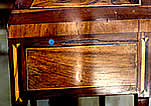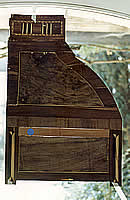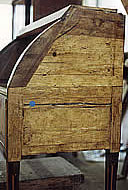| | | | You are here : Restore/conserve > Veneer and marquetry |
|  |
| |  |
| | A veneer is a leaf of precious wood stuck on a frame of solid wood. With the passing years, the species of wood differently warp and at the same time, the glue is drying and looses its adhesive ability. On the other hand , the varnish got dirty and hide the natural colour that the patina gave to these woods and even hides the ornamentation created by the inlayer. |
Veneers allowed the artisan to safe a huge amount of precious wood but also to create sophisticated ornamentations called marquetry.
| Problems: |
 |
Natural shading off of the glue |
 |
Blistered veneer |
 |
Veneer's slivers
|
 |
splits
|
 |
warpings |
|
Case Nr 3 : Steps of restoration of a writing desk:
Rolltop desk in rosenwood and fruit tree
Style: Louis XVI
Period : end of XVIIIth century
1. Taking out of the veneers:
As it is often the case, limited interventions was unfortunately nor possible nor recommendable for this furniture.Veneers pieces are maintained together by sticking on a sophisticated type of canvas to make sure that the ornamentation as well as the genuine joins are kept intact.The taking out must be realised in one shot, what is possible thanks to the fact that the bone glue, the fish glue or the likes used in the past are reversible.The process of taking out that is mastered by L'Atelier is based on the most advanced technologies invented up today to serve the art of restoration.
|  |
| 
 |
 |
 |
|
2. Veneers' restoration:
Working with his back to the light, the restorer is able to precisely locate the splits and the sand-throughs (by indiscriminate interventions thinned areas). The restoration is made on the back of the veneer. The sand throughs areas are doubled and the missing pieces are replaced with pieces of wood that precisely correspond to the genuine ones.
3. frame's restoration:
After the taking out, the frame in solid wood is restored (reduced splits, joins, twists,...).
4. Re-veneering:
Using an animal warm glue, like in the XVIIIth century, the veneers leaf sticked on the canvas is resticked under appropriate pression and warming . |
5. French polishing:
It is an incomparable natural finishing that brings out the vein and the colour of the wood. It has to be applied in many steps letting some days elapse between them. The first one consists in filling the tiny pores of the wood with pumice stone. Then the varnisher adds little liquid shell lac and natural resin. The artisan then applies his pad in circles and in figures of eight. This pad is a very private tool and the final result depends a lot on the skills, the dexterity, the experience and the patience of the varnisher.
|  |
|  |
|
| |
|
|
|
|
|
|
|
|
| | © |
|
|
|